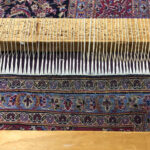Over time, colors fade, but your rug’s charm doesn’t have to. From the relentless sun’s rays to everyday wear and tear, various factors can rob your rug of its vibrant hues. However, in the world of textiles and artisan craftsmanship, there’s a mesmerizing technique that stands as a beacon of hope: rug dyeing and color restoration. Let’s dive into this intricate art and discover how to breathe vibrancy back into your cherished floor piece.
1. Understanding the Roots of Rug Dyeing
The tradition of rug dyeing dates back thousands of years. Ancient civilizations utilized natural ingredients—berries, roots, bark, and even insects—to craft stunning color palettes. Today, this age-old technique has evolved, melding traditional practices with modern advancements to achieve perfect color matches and enduring finishes.
2. The Necessity for Color Restoration
Why consider dyeing or color restoration? There are several reasons:
- Fading from Sunlight: Prolonged exposure to sunlight can cause your rug’s colors to fade, especially if it’s placed near windows or in sunlit areas.
- Wear and Tear: High traffic areas can wear down fibers, making colors appear muted over time.
- Chemical Damage: Accidental spills or using the wrong cleaning agents can lead to discoloration.
3. Choosing the Right Dye
A successful color restoration hinges on selecting the right dye:
- Natural Dyes: Extracted from plants and minerals, natural dyes offer a rich and authentic hue. They are eco-friendly and have been the choice for artisans for centuries.
- Synthetic Dyes: Developed through chemical processes, synthetic dyes come in a vast array of shades, allowing for precise color matching.
4. The Restoration Process
The intricate process of color restoration is a blend of science and art:
- Cleaning: Before dyeing, the rug is thoroughly cleaned to ensure the dye adheres properly.
- Color Matching: Experts assess the original colors to create a matching dye blend.
- Application: The dye is carefully applied, either by hand or using specialized equipment, ensuring even coverage and absorption.
- Setting the Dye: Heat or other techniques are used to set the dye, ensuring it won’t run or fade quickly.
5. Care Post-Restoration
After the rug is dyed and restored, it’s crucial to care for it properly:
- Avoid Direct Sunlight: Place your rug away from prolonged direct sunlight to prevent fading.
- Regular Cleaning: Regular cleaning with gentle, rug-safe products helps maintain the vibrancy of the colors.
- Rotate the Rug: Rotating your rug every few months ensures even wear and prevents color fading in high-traffic areas.
6. Trust in Expertise
Rug dyeing and color restoration are intricate processes, best left to professionals. A misstep can lead to uneven colors or further damage. This art demands a deep understanding of textiles, dyes, and the history of rug-making.
It’s essential to partner with experts who not only understand the science behind dyes but also respect the artistry of rugs. They should be able to navigate the delicate balance between restoring vibrancy and preserving the rug’s original charm and integrity.
The fading of colors is a natural progression in the lifespan of a rug, but it doesn’t mean the end of its allure. Through the art of rug dyeing and color restoration, these treasured pieces can find a new lease of life, gleaming with colors as vibrant as the day they were first woven. So, when you notice your beloved rug losing its luster, remember that there’s a world of color waiting to be rediscovered, and experts ready to guide you through the mesmerizing journey of restoration.

